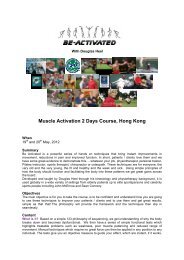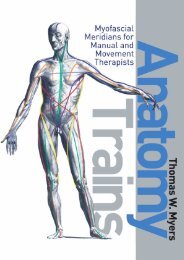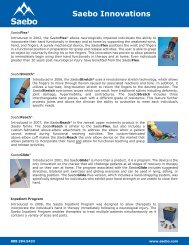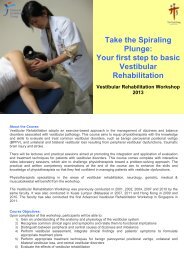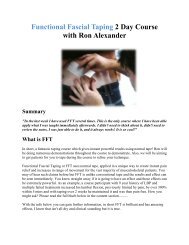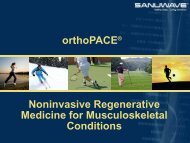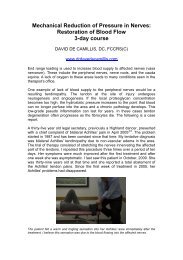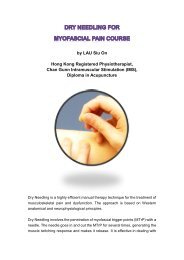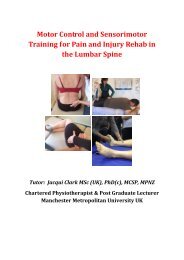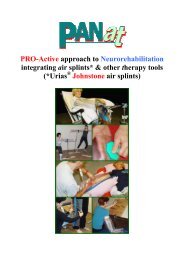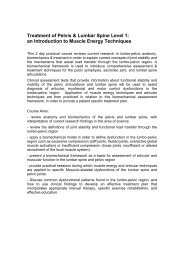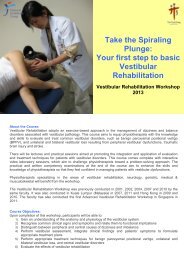31. Listening to Fascial System by Valentin C. Dones, Physiotherapist
31. Listening to Fascial System by Valentin C. Dones, Physiotherapist
31. Listening to Fascial System by Valentin C. Dones, Physiotherapist
- No tags were found...
Create successful ePaper yourself
Turn your PDF publications into a flip-book with our unique Google optimized e-Paper software.
<strong>Listening</strong> <strong>to</strong> <strong>Fascial</strong> <strong>System</strong>Use less force and treat patients with unbelievable results!Our hands and the brain are from the ec<strong>to</strong>derm. If the brain can think, would ourhands be able <strong>to</strong> do same?Memory exists in the fascia. Releasing it may call forth undesirable emotions.What is our role as manual physical therapists in correcting the fascia?Course Description/Program Overview:The fascial system is being recognized as the underlying cause of manyfunctional problems in the human being. In a perfectly healthy state, thefunction of fascial system is <strong>to</strong> maintain the body in equilibrium through adelicate balance of tension and elasticity. With the proper amount of tension, ithelps support the efficient alignment of our bones while being elastic enough <strong>to</strong>permit full, unrestricted movement.However, in response <strong>to</strong> physical trauma or inflammation, it begins losing itspliability. Slips and falls, whiplash, surgery or just habitually poor posturecreate fascial restrictions that accumulates over time. <strong>Fascial</strong> restrictions aredetected using hands. The fascia has memory which represents the recordingof an impression of the various traumas experienced <strong>by</strong> an individual.<strong>Listening</strong> technique detects these impressions and attenuates andsubsequently resolves them.A listening test involves placing a hand on some part of the body in order <strong>to</strong>detect underlying changes. Investigations in<strong>to</strong> the sensitivity of the hand haveshown that it can detect movements as small as ten microns in amplitude. Adifference of only five percent was found between measurements made <strong>by</strong> thehands and those recorded using a sophisticated apparatus.
Course Objectives:At the end of this session, it is expected that you will be able <strong>to</strong>:• Understand the fascial connections in the body• Identify fascial restrictions <strong>by</strong> palpation• Learn effective manual treatment technique for fascial restrictionsCourse Outcome:Upon completion of this course, participants will be able <strong>to</strong> apply all techniqueslearned immediately in their practice. It will enhance participants’ knowledgeand skills in assessment and treatment related <strong>to</strong> fascial restrictions.Course Instruc<strong>to</strong>r:<strong>Valentin</strong> C. <strong>Dones</strong> III has been practicing Manual Therapy for many years. Heis an academician, a clinician and a researcher. He concluded his BSPTdegree in the University of San<strong>to</strong> Tomas (UST), Manila, Philippines andcompleted his Masters Degree in Orthopedic Physical Therapy in UST incollaboration with the University of South Australia (UNISA). He had attainedhis Certificate in Orthopedic Manual Therapy and had completed the UpperQuarter and Lower Quarter of the Mulligan Course in CAPRI in India. Hefinished his Dorn Method Instruc<strong>to</strong>r Course under the Akademie fur HolistischeHeil-Arten International, Germany.Mr. <strong>Dones</strong> is a renowned local and international speaker whose main expertiseis on orthopedic manual therapy. With years of experience in Manual Therapy,he had already certified many health practitioners who opt <strong>to</strong> learnBiomechanical Taping and Dorn Method Therapy. He spearheads theCertification Course in Manual Therapy in the University of San<strong>to</strong> Tomas.Currently, he is taking his PhD in Health Sciences in the University of SouthAustralia with <strong>to</strong>pic on finding evidence behind diagnostic variables commonlyused in determining patients with lateral epicondylar pain.
Schedule:TimeDetails8.00 – 8.30 am Registration8.30 – 9.30am Highlights of FASCIAL LINKS9.30 – 10.30 am ROLE OF FASCIA10.30 – 11.00 am Morning Break11.00 – 1.00 pm GENERAL LISTENING TECHNIQUES in standingGENERAL LISTENING: Supine at AnkleGENERAL LISTENING: Lower Leg and ThighGENERAL LISTENING: Abdomen and ChestGENERAL LISTENING: Neck and Cranium1.00 – 2.00 pm Lunch2.00 – 3.00 pm <strong>Listening</strong> <strong>to</strong> Fascia in Upper Limb3.00 – 4.00 pm Induction and Re-equilibration Techniques4.00 – 4.15 pm Evening Break4.15 – 5.00 pm Question and AnswerDate: 28 March 2011 (Monday)Time: 9:00 am – 5:00 pmFee: $1000, 10% discount for registration before 31 Jan 2011. For interestedcandidate, please prepare the cheque in the name of HEMAX Health ProductsCompany Limited, with your name, address, email and telephone number onthe back and send <strong>to</strong> Rm 1508, Hollywood Plaza, 610 Nathan Road, MongKok. Please feel free <strong>to</strong> visit www.smarterehab.com, or contact Mr. LAU at2111 2880 / on.lau@hemaxhealth.com for any questions.HEMAX – Bringing the best courses worldwide <strong>to</strong> Hong Kong



